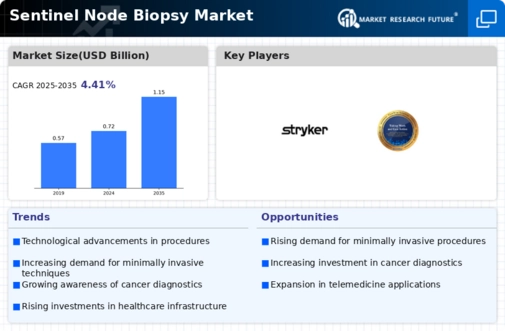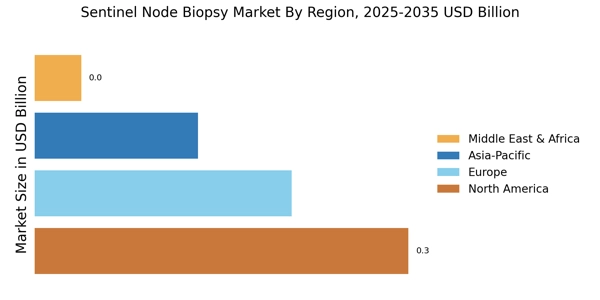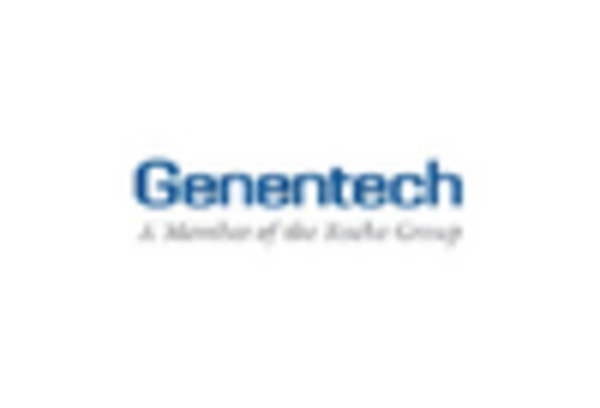Rising Cancer Incidence
The Sentinel Node Biopsy Market is significantly influenced by the rising incidence of various cancers, particularly breast and melanoma. According to recent statistics, breast cancer cases are expected to rise by 1.7 million annually, necessitating effective staging and treatment options. Sentinel node biopsy serves as a critical tool in determining the extent of cancer spread, thereby guiding treatment decisions. This increasing prevalence of cancer is likely to drive demand for sentinel node biopsy procedures, as healthcare providers seek to implement effective diagnostic strategies. The market is anticipated to expand as more patients are diagnosed and treated, with sentinel node biopsy becoming a standard practice in oncology. This trend underscores the importance of early detection and intervention in improving patient outcomes.
Increased Awareness and Education
The Sentinel Node Biopsy Market is also being propelled by increased awareness and education among both healthcare professionals and patients. Educational initiatives aimed at oncologists and surgeons are enhancing understanding of the benefits and applications of sentinel node biopsy. As more healthcare providers become knowledgeable about this technique, its adoption is likely to rise. Furthermore, patient awareness campaigns are informing individuals about the importance of early cancer detection and the role of sentinel node biopsy in treatment planning. This heightened awareness is expected to lead to an increase in the number of procedures performed, thereby driving market growth. The collaboration between medical institutions and advocacy groups is crucial in promoting education and awareness, ultimately benefiting the sentinel node biopsy market.
Regulatory Support and Guidelines
The Sentinel Node Biopsy Market is benefiting from supportive regulatory frameworks and guidelines that promote the use of this technique in clinical practice. Regulatory bodies are increasingly recognizing the importance of sentinel node biopsy in cancer management, leading to the establishment of clear guidelines for its implementation. This regulatory support is likely to enhance the credibility of sentinel node biopsy as a standard procedure, encouraging more healthcare providers to adopt it. Additionally, the approval of new imaging agents and technologies by regulatory authorities is expected to further stimulate market growth. As guidelines evolve to incorporate the latest evidence-based practices, the sentinel node biopsy market is poised for expansion, with an increasing number of institutions adopting this technique as part of their cancer treatment protocols.
Focus on Minimally Invasive Techniques
The Sentinel Node Biopsy Market is witnessing a growing emphasis on minimally invasive surgical techniques. As patients increasingly prefer procedures that reduce recovery time and minimize scarring, sentinel node biopsy has emerged as a favorable option. This technique allows for the removal of only the sentinel lymph nodes, thereby preserving surrounding tissues and reducing postoperative complications. The market is likely to benefit from this trend, as healthcare providers adopt less invasive methods to enhance patient satisfaction and outcomes. Additionally, the rise of outpatient surgical centers is facilitating the adoption of sentinel node biopsy, as these facilities often prioritize minimally invasive approaches. This shift in surgical philosophy is expected to contribute to the growth of the market in the coming years.
Technological Advancements in Sentinel Node Biopsy
The Sentinel Node Biopsy Market is experiencing a surge in technological advancements that enhance the accuracy and efficiency of procedures. Innovations such as fluorescence imaging and radioisotope-guided techniques are becoming increasingly prevalent. These technologies allow for real-time visualization of sentinel lymph nodes, thereby improving surgical outcomes. The integration of artificial intelligence in imaging analysis is also gaining traction, potentially leading to more precise identification of cancerous nodes. As a result, the market is projected to grow at a compound annual growth rate of approximately 7% over the next five years, driven by these advancements. Furthermore, the development of new imaging agents is likely to expand the applications of sentinel node biopsy, making it a more attractive option for healthcare providers.


















Leave a Comment